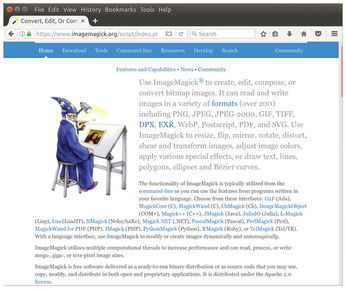Protect Your Privacy with ImageMagick
Tutorials – ImageMagick
Ben Everard wants to keep his location open, but only vaguely.
The ImageMagick tool lets you do almost everything you would want to with an image. You can tweak, poke, prod, and otherwise meddle with pixels (Figure 1). In this tutorial, we'll look at how to use this tool to form a command that can help protect our privacy online. This is also the perfect excuse to see how we can use the Linux terminal to build up a complex, powerful command from many smaller commands.
 Figure 1: If you ever need to interact with images from the command line, chances are that there's an ImageMagick tool for the job. Refer to ImageMagick.org to find out.
Figure 1: If you ever need to interact with images from the command line, chances are that there's an ImageMagick tool for the job. Refer to ImageMagick.org to find out.
When you take pictures on a digital camera, a whole lot of information is stored along with the actual image. The exact information varies from camera to camera but might include things like the camera settings and location at which the picture was taken. This information is all useful until you start sharing the images online, at which point it can be used to trace exactly where you've been. Many tools will just remove the location data, but we want to be a little more clever. We want to keep the general area the picture was taken but remove the precision. We want a command that embeds the location to the nearest town. Rather than put this information in hard-to-read metadata, we want the info displayed in the image itself as a caption at the bottom. This can be done as shown in Listing 1.
[...]
Buy Linux Magazine
Subscribe to our Linux Newsletters
Find Linux and Open Source Jobs
Subscribe to our ADMIN Newsletters
Support Our Work
Linux Magazine content is made possible with support from readers like you. Please consider contributing when you’ve found an article to be beneficial.

News
-
Parrot OS Switches to KDE Plasma Desktop
Yet another distro is making the move to the KDE Plasma desktop.
-
TUXEDO Announces Gemini 17
TUXEDO Computers has released the fourth generation of its Gemini laptop with plenty of updates.
-
Two New Distros Adopt Enlightenment
MX Moksha and AV Linux 25 join ranks with Bodhi Linux and embrace the Enlightenment desktop.
-
Solus Linux 4.8 Removes Python 2
Solus Linux 4.8 has been released with the latest Linux kernel, updated desktops, and a key removal.
-
Zorin OS 18 Hits over a Million Downloads
If you doubt Linux isn't gaining popularity, you only have to look at Zorin OS's download numbers.
-
TUXEDO Computers Scraps Snapdragon X1E-Based Laptop
Due to issues with a Snapdragon CPU, TUXEDO Computers has cancelled its plans to release a laptop based on this elite hardware.
-
Debian Unleashes Debian Libre Live
Debian Libre Live keeps your machine free of proprietary software.
-
Valve Announces Pending Release of Steam Machine
Shout it to the heavens: Steam Machine, powered by Linux, is set to arrive in 2026.
-
Happy Birthday, ADMIN Magazine!
ADMIN is celebrating its 15th anniversary with issue #90.
-
Another Linux Malware Discovered
Russian hackers use Hyper-V to hide malware within Linux virtual machines.

